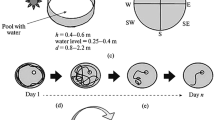The behavior of rats was studied in a two-ring maze in which the animal could make its own choice of one of two trajectories of the same length, independently returning to the start point. All maze sectors – starting chamber, signal sector, arm, and feeding sector – were separated by one-way doors. The time structure of passage through the maze sectors reflected both the level of the animal’s motivation and fully defined aspects of behavior, i.e., attention, short-term memory, and long-term memory, as well as the cognitive aspect, i.e., taking movement trajectory decisions on the basis of the conditioned signal presented, and the emotional aspect, i.e., assessment of the result of the action. Analysis of the time parameters of the activity allowed changes in various behavioral components to be evaluated in relation to treatment applied to the animals and ongoing status. We suggest that this behavioral model will be useful in different types of neuropharmacological, electrophysiological, and behavioral experiments.
Similar content being viewed by others
References
P. Ya. Gal’perin, An Introduction to Psychology: Textbook, Izd. Universitet, Moscow (1999).
K. A. Nikol’skaya, L. G. Voronin, and Sh. K. Sagimbaeva, “Physiological analysis of a skill acquired by white rats in a maze,” Dokl. Akad. Nauk SSSR, 217, No. 5, 1225–1228 (1974).
A. A. Orlov and V. P. Mochenkov, “Training of monkeys to complex behavioral tasks,” Zh. Vyssh. Nerv. Deyat., 43, No. 5, 869–877 (1993).
P. V. Simonov, The Emotional Brain Nauka, Moscow (1981).
R. M. J. Deacon and J. N. P. Rawlins, “T-maze alternation in the rodent,” Nature Protocols, 1, No. 1, 7–12 (2006).
J. Horner, “The effect of maze structure upon the performance of a multiple-goal task,” Anim. Learn. Behav., 12, No. 1, 55–61 (1984).
D. S. Olton, “Mazes maps and memory,” Am. Psychologist, 34, 583–596 (1979).
D. S. Olton and R. J. Samuelson, “Remembrance of places passed: Spatial memory in rats,” J. Exp. Psychol. Anim. Behav. Proc., 2, 97–116 (1976).
H. Shoji, H. Hagihara, L. Takao, et al., “T-maze forced alternation and left-right discrimination tasks for assessing working and reference memory,” J. Vis. Exp., Feb. 26, (60) (2012), pii: 3300, doi: 10.3791/3300.
Author information
Authors and Affiliations
Corresponding author
Additional information
Translated from Rossiiskii Fiziologicheskii Zhurnal imeni I. M. Sechenova, Vol. 100, No. 1, pp. 27–35, January, 2014.
Rights and permissions
About this article
Cite this article
Filatova, E.V., Orlov, A.A. & Afanas’ev, S.V. A Two-Ring Maze for Studies of the Behavior of Laboratory Animals. Neurosci Behav Physi 45, 765–770 (2015). https://doi.org/10.1007/s11055-015-0141-5
Received:
Published:
Issue Date:
DOI: https://doi.org/10.1007/s11055-015-0141-5




